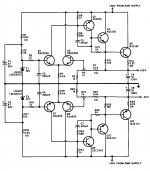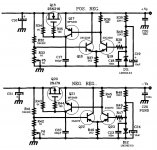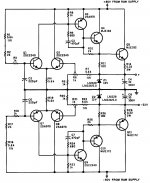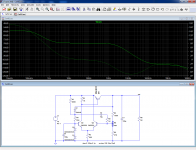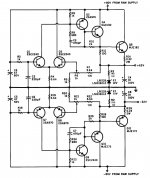Looks like it should be quite a good performer. 90 dB of loop gain easily, zener supply and zener noise are very well filtered, broadband noise should approach <4 µV with metal film resistors in feedback.It's a pity I never saw a voltage regulators comparison that included the Kit Ryan's regulator used for the Adcom GFA555. Here it's the high current version they used for it, but Nelson Pass used it to regulate the low current stages on his A75 power amp.
It could be argued that two 5.6-6.1 V zeners in series would have yielded better tempco, but since when do audio amps care about that anyway. Also, noise - as low as it is already - could be reduced further if you were to reduce AC gain to unity, but the required changes in compensation may prove detrimental to dynamic performance (going by opamps, unity gain compensation tends to go along with a hit in slew rate, and higher slew rate may be more beneficial in this case, especially if there's a variable load). Who needs a 62 V supply with sub-µV noise levels anyway.
This will do for a power amplifier supply:
High current dual rail regulator kit for power amplifier or bench power supply ! | eBay
Remember that the LM/LT 317/337 is only limited to 40 volts maximum BETWEEN INPUT AND OUTPUT, so +/- 67 volts @ 10 amps is quite possible, given adequate heat-sinking. This uses a pair of NJW0302G/NJW0281G transistors to provide the high current, whilst allowing the 317/337 to do the voltage regulation. This idea comes directly from the TI 317 datasheet. Add in Elvee's brilliant Denoiser:
D-Noizator: a magic active noise canceller to retrofit & upgrade any 317-based V.Reg.
and you have a super low-noise/low impedance, high voltage/high current power supply par excellence!
High current dual rail regulator kit for power amplifier or bench power supply ! | eBay
Remember that the LM/LT 317/337 is only limited to 40 volts maximum BETWEEN INPUT AND OUTPUT, so +/- 67 volts @ 10 amps is quite possible, given adequate heat-sinking. This uses a pair of NJW0302G/NJW0281G transistors to provide the high current, whilst allowing the 317/337 to do the voltage regulation. This idea comes directly from the TI 317 datasheet. Add in Elvee's brilliant Denoiser:
D-Noizator: a magic active noise canceller to retrofit & upgrade any 317-based V.Reg.
and you have a super low-noise/low impedance, high voltage/high current power supply par excellence!
Last edited:
I think I did mention that the current needs for this regulator will not be large, so I won't need the output transistors used for the Adcom.
Just run the LTSpice simulation, and the current is 16mA on one side and 6mA on the other.
That eBay won't do, because it's for high current, and what I need is high voltage. The input and output capacitors would have to be much larger in voltage. Probably 75v to 100v on the input, and 75v on the output. If I use that kit I would have to change the electrolytics, which would be fine, of course.
The D-noizator might a good idea, if I can adapt it for high voltages. I will ask at the thread.
If possible I would like to stick with my original proposal to use 317/337 for this project. As you can see voltages can be high, but currents will be low.
Just run the LTSpice simulation, and the current is 16mA on one side and 6mA on the other.
That eBay won't do, because it's for high current, and what I need is high voltage. The input and output capacitors would have to be much larger in voltage. Probably 75v to 100v on the input, and 75v on the output. If I use that kit I would have to change the electrolytics, which would be fine, of course.
The D-noizator might a good idea, if I can adapt it for high voltages. I will ask at the thread.
If possible I would like to stick with my original proposal to use 317/337 for this project. As you can see voltages can be high, but currents will be low.
Today I found one of the articles, from The Audio Amateur magazine, where they used a 317/337 pair to modify an Erno Borbely 60w amplifier published years before on that same magazine.
One important thing mentioned on that article is that the author did consider the TL783, but considered the voltage drop too large: 10-15v. Indeed it is.
So I went back to have a look at two similar discrete regulators that I think might be simple and good options.
Kit Ryan's supply has the advantage of being completely bipolar, meanwhile Borbely's uses MOSFETs that you can't find now.
Your opinions over this are important to me.
One important thing mentioned on that article is that the author did consider the TL783, but considered the voltage drop too large: 10-15v. Indeed it is.
So I went back to have a look at two similar discrete regulators that I think might be simple and good options.
Kit Ryan's supply has the advantage of being completely bipolar, meanwhile Borbely's uses MOSFETs that you can't find now.
Your opinions over this are important to me.
Attachments
You can use any modern day MOSFET of equivalencymeanwhile Borbely's uses MOSFETs that you can't find now.
Look at that, even Toshiba has introduced new p-ch mosfets in through hole.
Through Hole 1 Channel P-Channel MOSFET | Mouser Canada
drop out voltage is dependent on load current, 10-15v >500mA, >500mA load is a whole lot of power, what load current do you need for your application? 50*500mA = 25Watttsthe author did consider the TL783, but considered the voltage drop too large: 10-15v. Indeed it is.
Last edited:
Today I found one of the articles, from The Audio Amateur magazine, where they used a 317/337 pair to modify an Erno Borbely 60w amplifier published years before on that same magazine.
One important thing mentioned on that article is that the author did consider the TL783, but considered the voltage drop too large: 10-15v. Indeed it is.
So I went back to have a look at two similar discrete regulators that I think might be simple and good options.
Kit Ryan's supply has the advantage of being completely bipolar, meanwhile Borbely's uses MOSFETs that you can't find now.
Your opinions over this are important to me.
Both can be improved for zero extra cost by feeding the reference string from the output instead of from the input.
Also, by making the reference voltage higher you get extra loop gain thus better performance, also for free. What's not to like!
Jan
Less than 20mA = peanuts, basically the min load spec for a TL783 to stay in lock.
The N-ch device does not need to be a true complementary device, if one even exists for a MOSFET, use anyone that meets your requirements. I only mention P-ch since they are not as available as N-ch devices are.
Jan, the man, has your PS needs in hand
The N-ch device does not need to be a true complementary device, if one even exists for a MOSFET, use anyone that meets your requirements. I only mention P-ch since they are not as available as N-ch devices are.
Jan, the man, has your PS needs in hand
Both can be improved for zero extra cost by feeding the reference string from the output instead of from the input.
Also, by making the reference voltage higher you get extra loop gain thus better performance, also for free. What's not to like!
Jan
Thanks, Jan!
Can you add the suggested corrections on the schematics, hand drawn even? It might help other people.
I will draw them better and perhaps open another thread just for that.
You might now know of anyone that compared the Kit Ryan's regulator to the the other super ones, do you? Measurements wise?
Thanks, Jan!
Can you add the suggested corrections on the schematics, hand drawn even? It might help other people.
I will draw them better and perhaps open another thread just for that.
You might now know of anyone that compared the Kit Ryan's regulator to the the other super ones, do you? Measurements wise?
It is very simple. Look at the zener that forms the reference on one base. That zener is fed by some R's from Vin. Change that to be fed from Vout. R1/R16 on the left schematic, R39/R48 on the right one. That's all. You can keep the caps that decouple that R string or trash them, doesn't make a difference after the mod.
I'm not aware of any measurements with this reg.
Jan
Less than 20mA = peanuts, basically the min load spec for a TL783 to stay in lock.
The TL783 still requires me to power it from separate transformer secondary pairs, which would limit its application to such wirings. The discrete regulators do not require that.
It is very simple. Look at the zener that forms the reference on one base. That zener is fed by some R's from Vin. Change that to be fed from Vout. R1/R16 on the left schematic, R39/R48 on the right one. That's all. You can keep the caps that decouple that R string or trash them, doesn't make a difference after the mod.
You mean something like this? Wouldn't this output 12v?
Attachments
No, here is a more reasonable version:
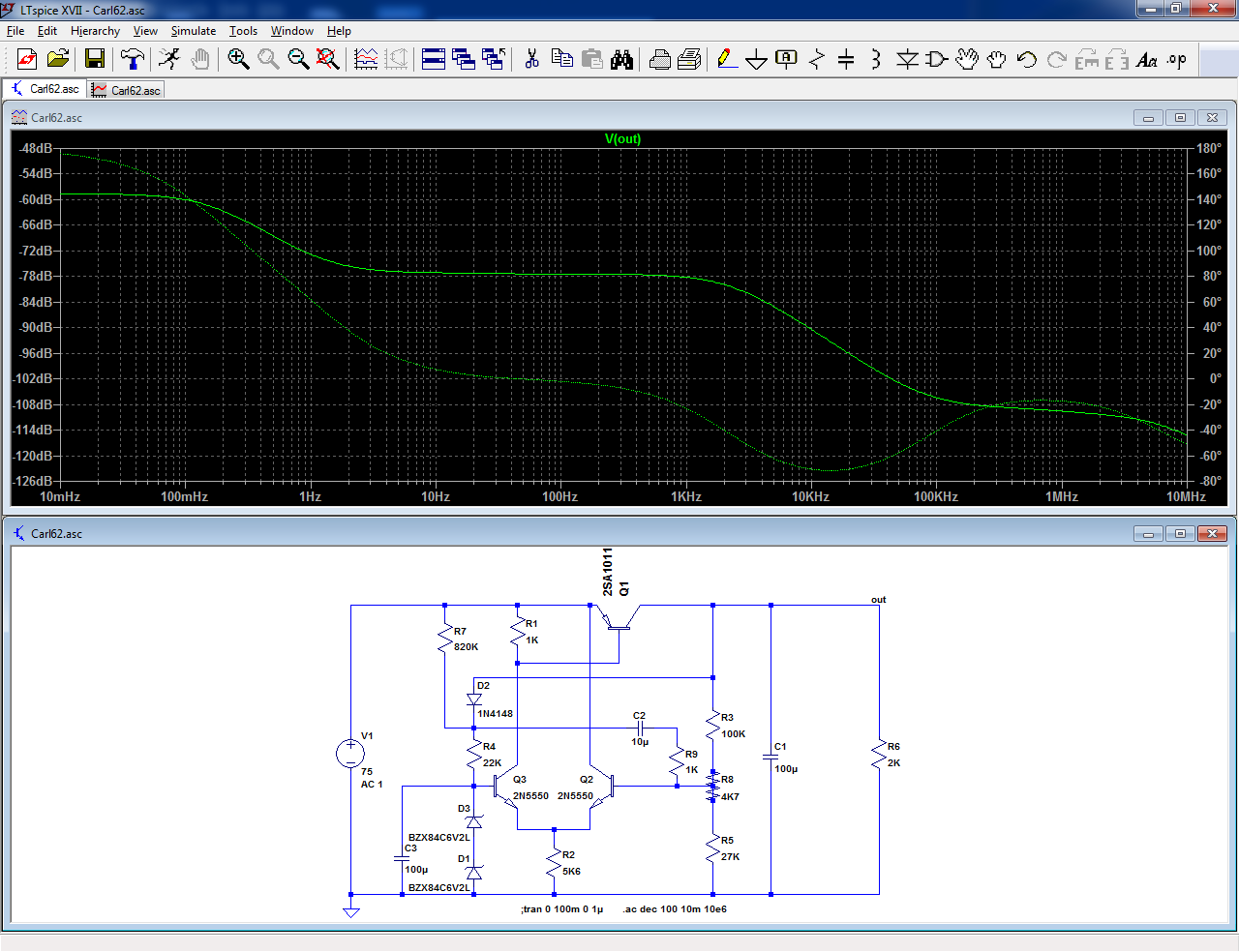
I didn't explore stability details, but omitting the triples and considering the moderate loop gain + the common emitter config, the compensation using the output cap to set the dominant pole should be OK (from experience, it works rather well).
The semi's are not critical and are just indicative. Use complementaries for the other side.
PSRR in the auidio range is ~78dB, which is probably better than you could expect from a TL783-like reg.
It doesn't match a denoiser, but why would you need better than that for such a mundane task?
I didn't explore stability details, but omitting the triples and considering the moderate loop gain + the common emitter config, the compensation using the output cap to set the dominant pole should be OK (from experience, it works rather well).
The semi's are not critical and are just indicative. Use complementaries for the other side.
PSRR in the auidio range is ~78dB, which is probably better than you could expect from a TL783-like reg.
It doesn't match a denoiser, but why would you need better than that for such a mundane task?
Attachments
You mean something like this? Wouldn't this output 12v?
No, here the zener is across Vout, that'll release all the build-in smoke in the zener. Take the whole ref string, not just the zener, R1/R6 or R39/R48 down through the zener to ground, and feed that string not from Vin but from Vout.
It is very simple. Look at the zener that forms the reference on one base. That zener is fed by some R's from Vin. Change that to be fed from Vout. R1/R16 on the left schematic, R39/R48 on the right one. That's all. You can keep the caps that decouple that R string or trash them, doesn't make a difference after the mod.
Jan
No, here is a more reasonable version:

I didn't explore stability details, but omitting the triples and considering the moderate loop gain + the common emitter config, the compensation using the output cap to set the dominant pole should be OK (from experience, it works rather well).
The semi's are not critical and are just indicative. Use complementaries for the other side.
PSRR in the auidio range is ~78dB, which is probably better than you could expect from a TL783-like reg.
It doesn't match a denoiser, but why would you need better than that for such a mundane task?
I like it.
Improving on the TL783 means we are in the right path. Would it be an improvement on the 317/1085?
How would you add the changes Jan suggests on your LTSpice simulation?
No, here the zener is across Vout, that'll release all the build-in smoke in the zener. Take the whole ref string, not just the zener, R1/R6 or R39/R48 down through the zener to ground, and feed that string not from Vin but from Vout.
Closer to what you suggested?
What do you think of Elvee's LTSpice demo schematic?
Attachments
No. You need to feed the diff amp's non inverting input from the zener reference and the inverting input from the output voltage divider.
Isn't that what the Kit Ryan's PS already does?
78dB PSRR is about the same as the TL783, and somewhat better than the 317Would it be an improvement on the 317/1085?
I think they are included (you should ask for confirmation), and in addition the startup circuit necessary with this configuration is also included, as is the FB bypass to improve AC performance, + the output-reduction surgeryHow would you add the changes Jan suggests on your LTSpice simulation?
- Home
- Amplifiers
- Power Supplies
- Using the LM317 with higher voltages
